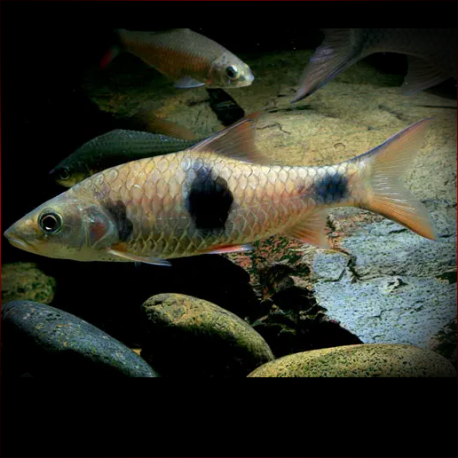More info
Datasheet
| Minimum Tank Size | 860 litres / 227.19 US gallons |
| Maximum Size | 20.1cm / 7.91inches |
| Temperature | 20°C / 68.00°F - 26°C / 78.80°F |
| Hardness | 2.02dgH / 36ppm - 20.00dgH / 357ppm |
| pH | 6.0-8.0 |
General Description
Hampala Salweenensis is a poorly-known species in the aquarium trade, recognizable by its distinct color patterns, lateral line scales, and caudal fin characteristics. With a maximum size of 20.1cm, it belongs to the Cyprinidae family and is classified under Cypriniformes.
Aquarium Setup
The ideal tank setup for Hampala Salweenensis involves creating a river-like environment with a substrate of rocks, gravel, boulders, and driftwood. Water quality is crucial, necessitating spotless conditions, high dissolved oxygen levels, and significant water movement. It requires a tank of minimum 860 litres, with water parameters ranging from a pH of 6.0-8.0, hardness of 36-357ppm, and a temperature of 20-26°C.
Behaviour
This species captures prey using suction and is known to be peaceful with tankmates it can't swallow. It tends to outcompete slow-moving or timid species and should be housed with cyprinids, characids, catfishes, and larger botiid loaches. H. Salweenensis is gregarious, forming a pecking order in groups of five or more, preventing excessive antagonism in subdominant individuals.
Feeding and Diet
Predatory in nature, in the wild H. Salweenensis feeds on smaller fishes, insects, crustaceans, and plant material. In captivity, it accepts dried foods but thrives on live and frozen items like bloodworms, prawns, earthworms, mussels, and whitebait. Overfeeding should be avoided, along with mammalian/avian meat and feeder fish to prevent health issues.
Reproduction & Dimorphism
Reproductive behavior of H. Salweenensis is unrecorded, but sexually mature females are likely to have a thicker body compared to males. A calm and undisturbed environment in the aquarium may encourage breeding behavior, though specifics are not well-documented.
Habitat and Distribution
Endemic to the River Salween basin, the distribution of H. Salweenensis within its watershed remains unclear. It is found in clear, well-oxygenated, running waters with various substrates. Recorded from regions like northwestern Thailand and Shan State, Myanmar, this species thrives in both upland and lowland environments within the river system.

